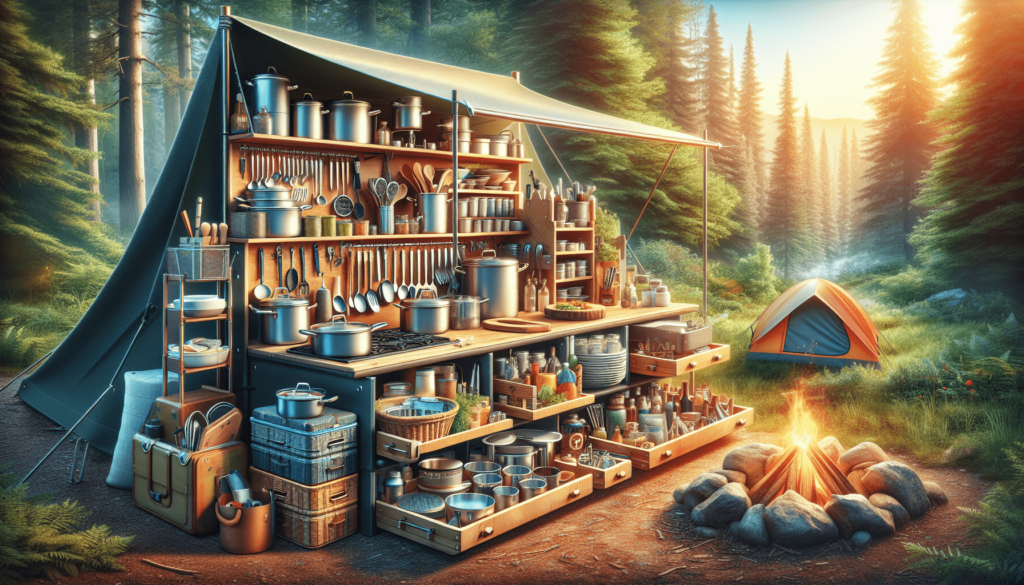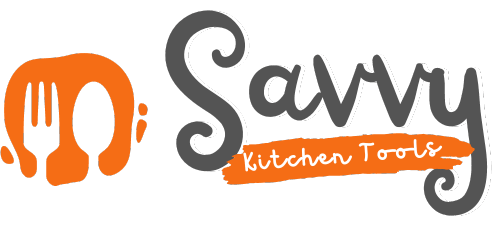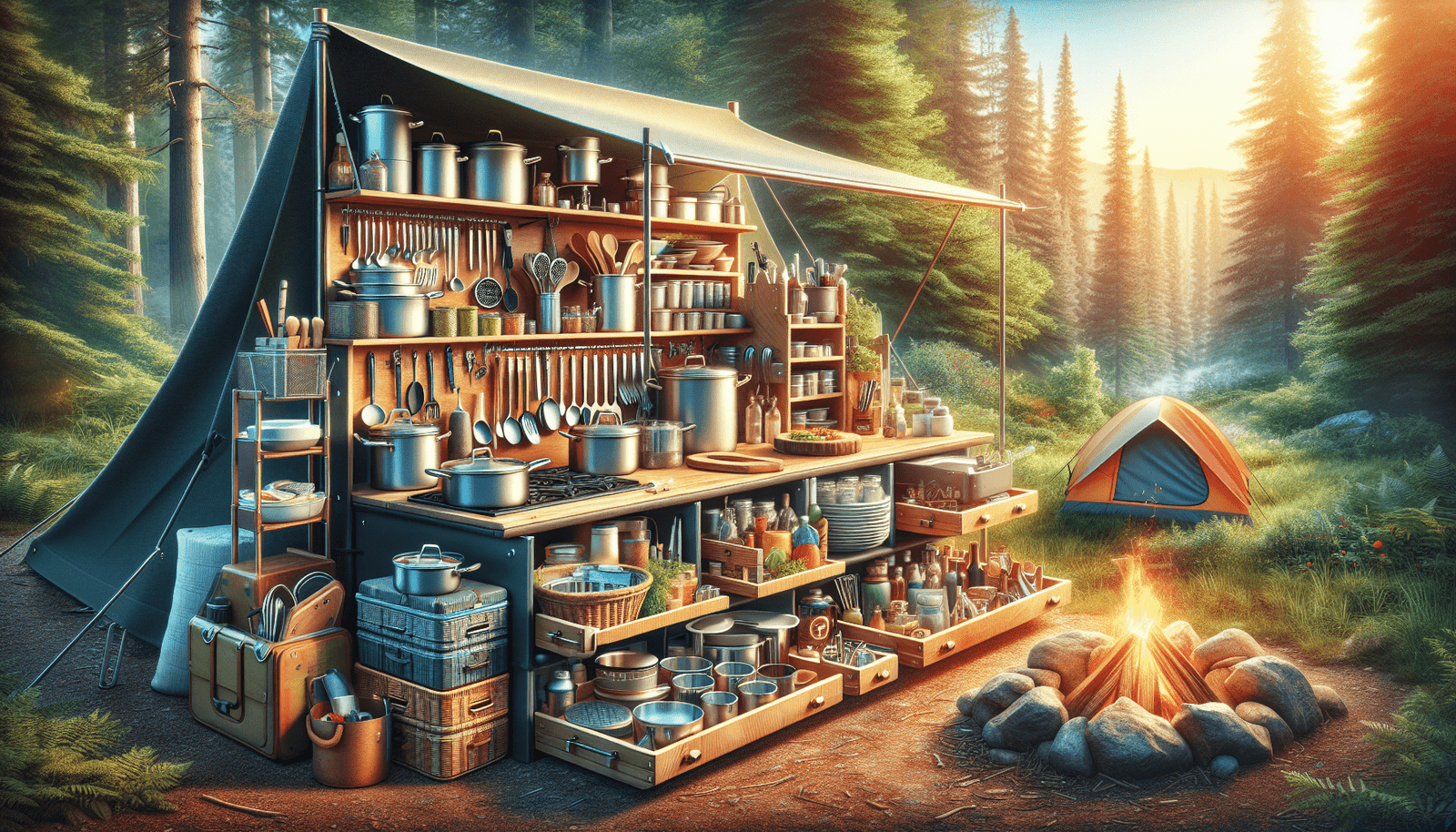Imagine the joy of cooking in the great outdoors, surrounded by nature’s beauty and basking in the warm sunlight. But hold on, have you ever found yourself rummaging through bags and boxes, desperately searching for that one essential utensil or spice? Fear not, because in this article, we will reveal the secrets to mastering the art of camp kitchen organization. From clever storage solutions to strategic meal planning, you’ll learn how to create a well-organized and efficient camp kitchen, ensuring that every outdoor cooking experience is a delight. So pack your camping gear and get ready to embrace the pristine wilderness, armed with the knowledge to conquer any culinary challenge that comes your way.

Choosing the Right Camp Kitchen Gear
When it comes to camping, having the right camp kitchen gear can make a world of difference in your cooking experience. Here are some essential cooking equipment to consider for your camping adventures.
Essential cooking equipment
First and foremost, a reliable camping stove is a must-have. Look for one that is lightweight, easy to set up, and has multiple burners for cooking convenience. Additionally, invest in a good set of cookware that includes pots, pans, and utensils. Opt for durable, non-stick options that are easy to clean and can withstand outdoor conditions.
Portable and compact options
Since space is often limited when camping, choosing portable and compact kitchen gear is essential. Look for collapsible tables and chairs that are easy to transport and set up. Consider investing in lightweight and foldable cutting boards, colanders, and drying racks as well. These compact options will save valuable space in your camp kitchen setup.
Multi-functional tools
To maximize efficiency and minimize the number of items you need to carry, consider investing in multi-functional tools. Look for utensils that can serve multiple purposes, such as a spork that can act as a spoon, fork, and even a knife. Additionally, consider getting a versatile camping tool that combines a can opener, bottle opener, and screwdriver in one. These multi-functional tools can significantly simplify your camp kitchen setup.
Organizing Your Camp Kitchen
To ensure a smooth and enjoyable cooking experience while camping, it’s important to have an organized camp kitchen. Here are some tips to help you keep your kitchen gear in order.
Packing checklist
Before heading out on your camping trip, create a packing checklist specifically for your camp kitchen. This will help you ensure that you have all the necessary items and prevent any last-minute scrambling. Include essential items like cooking utensils, cookware, cleaning supplies, and food storage containers on your checklist. By following a packing checklist, you can stay organized and avoid forgetting important items.
Storage solutions
Invest in quality storage solutions to keep your camp kitchen organized. Use sturdy plastic bins or storage containers to store your kitchen gear and food supplies. Label each container to make it easier to find what you need when setting up your kitchen. Additionally, consider using clear containers to easily identify the contents. Utilizing storage solutions will not only keep your camp kitchen organized but also protect your gear from damage during travel.
Categorizing kitchen items
Sort your kitchen items into categories for easy access and organization. For example, group all your cooking utensils together, separate your cookware, and keep cleaning supplies in their own designated area. This arrangement will help you quickly find what you need without digging through a jumbled mess of items. When categorizing, consider the frequency of use and place frequently used items in easily accessible locations.
Labeling containers
Labeling containers can significantly streamline your camp kitchen setup and organization process. Use waterproof labels or permanent markers to clearly mark the contents of each container. This will save you time and effort when searching for specific items and prevent any confusion when multiple people are involved in the camp kitchen setup. Labels are especially useful for identifying containers that have similar appearances, such as storage containers for different types of ingredients.
Setting Up Your Camp Kitchen
Once you reach your campsite, setting up your camp kitchen in the right location is crucial. Follow these tips to ensure a safe and efficient kitchen setup.
Choosing a suitable location
Select a location for your camp kitchen that is level and away from any potential hazards such as flammable materials or overhanging branches. Look for an area with adequate ventilation to prevent the buildup of smoke or cooking fumes. Additionally, consider the proximity to other camp activities and ensure that your kitchen setup won’t interfere with other campers.
Safe food handling practices
Practicing safe food handling is essential to prevent foodborne illnesses while camping. Wash your hands thoroughly with soap and water before handling any food. Use separate cutting boards and utensils for raw meats and ready-to-eat foods to avoid cross-contamination. Cook food to the appropriate internal temperatures and store perishable items in a cooler with ice to maintain food safety.
Setting up cooking and cleaning stations
When setting up your camp kitchen, designate separate areas for cooking and cleaning. Set up your camping stove in a clear area, away from any flammable materials. Ensure that there is sufficient space to safely operate the stove and move around while cooking. Set up a wash station with a basin or collapsible sink for easy dishwashing and handwashing. Having dedicated stations for cooking and cleaning will help keep your camp kitchen organized and efficient.
Preventing Food Spoilage
To ensure your food stays fresh and safe to consume during your camping trip, it’s crucial to take steps to prevent food spoilage. Here are some tips to help you keep your perishable items fresh.
Proper food storage
Invest in high-quality coolers and ice packs to keep your perishable food items at a safe temperature. Pack raw meats separately and place them at the bottom of the cooler to prevent cross-contamination. Store food in airtight containers or resealable bags to protect them from moisture and pests. Consider using frozen water bottles instead of loose ice to avoid soggy food.
Meal planning and portion control
Proper meal planning can help reduce food waste and prevent spoilage. Plan your meals in advance and only bring the necessary ingredients for each dish. Pre-portion your ingredients to avoid excess leftovers that may go to waste. By planning your meals and portioning ingredients accordingly, you can minimize the risk of food spoilage during your camping trip.
Utilizing coolers and ice
Maintaining the temperature of your coolers is crucial for preventing food spoilage. Pack your cooler strategically, with perishable items close to the ice or ice packs. Keep your cooler in the shade and avoid opening it frequently to retain cold temperatures. Consider using separate coolers for different types of food to prevent cross-contamination. Following these guidelines will help keep your food fresh and safe throughout your camping trip.

Maintaining Hygiene and Cleanliness
Hygiene and cleanliness are essential aspects of any camp kitchen setup. By following these practices, you can ensure a sanitary cooking environment.
Handwashing facilities and techniques
Proper handwashing is crucial to prevent the spread of bacteria and maintain hygiene while cooking. Set up a handwashing station near your camp kitchen with a basin, water jug, and soap. Wash your hands thoroughly with soap and water for at least 20 seconds before handling any food or utensils. Encourage everyone in your camping group to practice proper handwashing techniques regularly.
Dishwashing methods
Maintaining clean dishes and utensils is important to prevent the buildup of bacteria and maintain the quality of your meals. Use biodegradable dish soap and warm water to wash your dishes. Scrub them thoroughly to remove any food remnants. Rinse dishes with clean water and air dry them or use a microfiber towel to ensure they are fully dry before storing. Proper dishwashing will help prevent contamination and maintain cleanliness in your camp kitchen.
Waste management
Proper waste management is not only important for maintaining cleanliness but also for preserving the natural environment. Have designated trash bags or containers for different types of waste, such as food scraps and non-recyclable items. Dispose of your waste properly by following campground guidelines or packing it out if necessary. Keep your campsite clean and free from litter to minimize the impact on the environment and other campers.
Maximizing Space and Efficiency
When camping, space is often limited, so it’s essential to maximize the available space in your camp kitchen. These tips will help you make the most of your kitchen setup.
Utilizing vertical space
Make use of vertical space by hanging items on hooks or investing in hanging organizers. Hang utensils, pots, and pans on a wall or tree branch using hooks or a carabiner. Additionally, consider using a hanging organizer with multiple pockets to store small items such as spices and cooking utensils. Utilizing vertical space will allow you to free up valuable counter space and keep your camp kitchen organized.
Foldable and collapsible kitchenware
Invest in foldable and collapsible kitchenware to save space when packing and setting up your camp kitchen. Look for collapsible bowls, colanders, and storage containers that can shrink down to a fraction of their original size when not in use. Foldable cutting boards and drying racks are also excellent space-saving options. These compact kitchenware items will make the most of your limited camping space.
Compact storage solutions
Invest in compact storage solutions to keep your camp kitchen neat and organized. Look for stackable storage containers that can easily fit into your storage bins. Opt for nesting pots and pans that take up minimal space when stacked together. Consider using resealable bags or vacuum-sealed bags for storing small ingredients to save space. Compact storage solutions will help streamline your kitchen setup and make the most efficient use of available space.
Meal Preparation Tips
Preparing meals while camping can be simplified with these helpful tips. With a bit of planning and preparation, you can enjoy delicious meals in the great outdoors.
Pre-cutting and pre-measuring ingredients
Simplify your meal preparation process by pre-cutting and pre-measuring ingredients before leaving for your camping trip. Chop vegetables, portion out spices, and even marinate meats ahead of time. By prepping ingredients in advance, you can save time at the campsite and have everything ready for cooking. Store pre-cut ingredients in resealable bags or containers for easy access and to maintain freshness.
One-pot recipe ideas
One-pot meals are perfect for camping as they require minimal cleanup and are convenient to cook over a camping stove. Look for one-pot recipe ideas that combine protein, grains, and vegetables into a single dish. Recipes like chili, stir-fries, or pasta with sauce are great options. By preparing one-pot meals, you can enjoy a satisfying and delicious meal without the hassle of cleaning multiple pots and pans.
Quick and easy meal options
Sometimes, quick and easy meals are the way to go when camping. Sandwiches, wraps, and salads that require minimal cooking are great options for lunch or quick dinners. Pack easy-to-prep snacks like granola bars, trail mix, and fresh fruits for on-the-go energy. Having a variety of quick and easy meal options on hand will ensure that you can enjoy a tasty meal without spending too much time on preparation.
Cleaning and Maintaining Equipment
Proper cleaning and maintenance of your camp kitchen equipment will prolong its lifespan and keep it in good working condition. Follow these guidelines to ensure your gear stays in top shape.
Regular cleaning routine
Establish a regular cleaning routine for your camp kitchen equipment. Thoroughly clean all cooking utensils, pots, and pans after each use. Use warm water and biodegradable soap to remove any food remnants. Dry them thoroughly to prevent rust or mold. Similarly, clean your camping stove and wipe down surfaces regularly. By maintaining a regular cleaning routine, you can prevent the buildup of bacteria and ensure the longevity of your equipment.
Proper maintenance and repair
Inspect your camp kitchen equipment regularly for any signs of wear or damage. Tighten loose screws, replace worn-out parts, and fix any leaks or malfunctioning components. Keep a small repair kit with essential tools and spare parts for minor repairs. Regular maintenance and timely repairs will keep your camp kitchen equipment in excellent working condition and prevent any unexpected breakdowns during your camping trip.
Long-term storage considerations
When your camping trip comes to an end, proper storage of your camp kitchen equipment is important. Ensure that all items are clean and dry before storing them to prevent mold or mildew growth. Disassemble any parts that can be separated to save space. Consider using storage bags or cases to protect your equipment from dust and damage. Store your gear in a cool and dry location to prevent rust or corrosion. Taking these long-term storage considerations into account will help prolong the life of your camp kitchen equipment.
Safety Measures
While enjoying your camping experience, it’s crucial to prioritize safety. Follow these safety measures to ensure a safe camp kitchen setup.
Fire safety precautions
When using a camping stove or cooking over an open fire, it’s important to follow fire safety precautions. Choose a location for your stove or fire that is away from flammable materials, such as dry leaves or tents. Never leave your stove or fire unattended. Keep a fire extinguisher or a bucket of water nearby for emergencies. By taking fire safety precautions, you can prevent accidents and maintain a safe camp kitchen environment.
Proper propane usage and storage
If you’re using a propane camping stove, ensure that you follow proper usage and storage guidelines. Check for any gas leaks before connecting the propane tank and make sure all connections are secure. Never use or store propane tanks inside your tent or any enclosed spaces. When not in use, disconnect the tank and store it in a well-ventilated area away from direct sunlight or heat sources. By practicing proper propane usage and storage, you can minimize the risk of accidents and ensure everyone’s safety.
Storing sharp tools securely
When camping, it’s common to have sharp tools such as knives and cooking utensils. Ensure that these items are stored securely when not in use. Use blade guards or sheaths to cover knives and wrap sharp utensils in cloth or protective sleeves. Store them in a designated area where they won’t accidentally cause harm. By storing sharp tools securely, you can prevent accidents and ensure the safety of everyone in your campsite.
Essential Camp Kitchen Accessories
In addition to the essential cooking equipment, there are a few accessories that can enhance your camp kitchen experience. Consider these must-have accessories for a well-equipped camp kitchen.
Collapsible sink or basin
A collapsible sink or basin is a versatile accessory that serves multiple purposes in your camp kitchen. It can be used for washing dishes, as a makeshift ice bucket, or even for bathing if needed. Look for a compact and lightweight option that can be easily folded and stored when not in use. By having a collapsible sink or basin, you can enjoy the convenience of a portable washing station without taking up much space.
Portable spice rack
Enhance the flavor of your camp meals with a portable spice rack. Look for a compact spice container that has multiple compartments for different spices. Fill each compartment with your favorite spices and label them for easy identification. A portable spice rack will allow you to add flavor to your dishes without the need to carry individual spice containers.
Camp kitchen organizer
A camp kitchen organizer can help keep your cooking utensils and supplies in order. Look for an organizer with multiple pockets and compartments to store various items such as cooking utensils, condiments, and even small kitchen gadgets. Choose a compact and lightweight organizer that can easily be hung or placed on a table. Having a camp kitchen organizer will help prevent your camp kitchen from becoming chaotic and ensure that everything has its place.
In conclusion, choosing the right camp kitchen gear, organizing your camp kitchen efficiently, and following proper safety and hygiene practices are essential for a successful camping trip. By investing in the right equipment, arranging your kitchen setup thoughtfully, and following safety measures, you can enjoy delicious meals and a clean camping experience. So pack your gear, follow these tips, and get ready for a delightful culinary adventure in the great outdoors!


